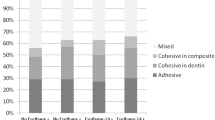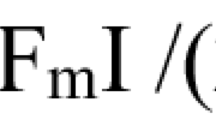Abstract
The traditional fiber reinforced composite (FRC) contains bisphenol A glycidyl methacrylate (bis-GMA) in the resin matrix, which is thought to have some disadvantages. This research aimed at replacing bis-GMA with another monomer—urethane dimethacrylate (UEDMA), with the desired properties for dental use still retained. Four groups were prepared with light-curing (n = 30), one Control group with a bis-GMA-based resin matrix and three experimental groups with UEDMA-based matrices (Exper 1, Exper 2 and Exper 3 with a varying UEDMA weight percentage). Specimens were stored in dry conditions for 24 h or in deionized water for 1, 3, 6 or 12 months prior to the tests. Water sorption (n = 6), Vicker’s hardness (n = 6) and flexural properties (n = 6) after each storage time were investigated. Scanning electron microscopy (SEM) images were taken at the fracture sites after 3-point bending. All the results were statistically analyzed (α = 0.05). The Exper 1 group exhibited the lowest weight increase after water storage among the experimental groups. As for dry conditions, 1- and 6-month storage, different resin matrix compositions made no significant difference to hardness, while for 3- and 12-month storage, “Control” possessed the highest hardness. The Control group’s strength and modulus, Exper 1 and Exper 2’s modulus were stable during water storage. Compared to other experimental groups, Exper 1 had the highest strength and modulus values with most of the storage times. SEM images showed relatively good adhesion between the fiber and the matrix. With all the tested properties considered, the Exper 1 group had superior performance among all the three experimental groups.







Similar content being viewed by others
References
Zhang M, Matinlinna JP. E-Glass fiber reinforced composites in dental applications. Silicon. 2012;4:73–8.
Vallittu PK. Survival rates of resin-bonded, glass fiber–reinforced composite fixed partial dentures with a mean follow-up of 42 months: a pilot study. J Pros Dent. 2004;9:241–6.
Le Bell-Rönnlöf AM, Lassila LV, Kangasniemi I, Vallittu PK. Load-bearing capacity of human incisor restored with various fiber-reinforced composite posts. Dent Mater. 2011;27:107–15.
Olsen CM, Meussen-Elholm ET, Samuelsen M, Holme JA, Hongslo JK. Effects of the environmental oestrogens bisphenol A, tetrachlorobisphenol A, tetrabromobisphenol A, 4-hydroxybiphenyl and 4,4′-dihydroxybiphenyl on oestrogen receptor binding, cell proliferation and regulation of oestrogen sensitive proteins in the human breast cancer cell line MCF-7. Pharmacol Toxicol. 2003;92:180–8.
Gwynne L, Bisphenol A A Known Endocrine Disruptor (A WWF European Toxics Programme Report). http://www.wwf.org.uk/filelibrary/pdf/bpa.pdf. (2000). Accessed 30 May 2012.
Rathee M, Malik P, Singh J. Bisphenol A in dental sealants and its estrogen like effect. Indian J Endocr Metab. 2012;16:339–42.
Moszner N, Fischer UK, Angermann J, Rheinberger V. A partially aromatic urethane dimethacrylate as a new substitute for Bis-GMA in restorative composites. Dent Mater. 2008;24:694–9.
Nosbi Norlin, Akil Hazizan Md, Mohd Ishak ZA, Abu Bakar A. Degradation of compressive properties of pultruded kenaf fiber reinforced composites after immersion in various solutions. Mater Des. 2010;30:4960–4.
Darvell BW. Materials Science for Dentistry. 8th ed. The University of Hong Kong; 2006.
Blake A. Handbook of mechanics, materials, and structures. Malden: Wiley-Interscience; 1985.
Lassila LVJ, Tanner J, Le Bell A-M, Narva K, Vallittu PK. Flexural properties of fiber reinforced root canal posts. Dent Mater. 2004;20:29–36.
Bae JM, Kim KN, Hattori M, Hasegawa K, Yoshinari M, Kawada E, Oda Y. The flexural properties of fiber-reinforced composite with light-polymerized polymer matrix. Int J Prosthodont. 2001;14:33–9.
Väkiparta M, Yli-urpo A, Vallittu PK. Flexural properties of glass fiber reinforced composite with multiphase biopolymer matrix. J Mater Sci Mater Med. 2004;15:7–11.
Matinlinna JP, Dahl JE, Karlsson S, Lassila LVJ, Vallittu PK. The effect of the novel silane system on the flexural properties of E-glasss fiber-reinforced composites for dental use. In: Mittal KL, editor. Silanes and Other Coupling Agents. The Netherlands: VSP/Brill Leiden; 2007. Vol. 4, pp. 83–97.
Le Bell-Rönnlöf A-M. Fiber-reinforced composites as root canal posts. Turku: The University of Turku; 2007.
Brown R. Handbook of polymer testing: short-term mechanical tests. iSmithers; 2002.
Zhang M, Matinlinna JP. The effect of resin matrix composition on mechanical properties of E-glass fiber-reinforced composite for dental use. J Adhes Sci Technol. 2011;25:2687–701.
Vallittu PK In: Matinlinna JP, Mittal KL (eds) Adhesion aspects in dentistry, BRILL/VSP, Leiden, The Netherlands, 2009; 63–74.
Baschek G, Hartwig G, Zahradnik F. Effect of water absorption in polymers at low and high temperatures. Polymer. 1999;40:3433–41.
Rueggeberg FA. From vulcanite to vinyl, a history of resins in restorative dentistry. J Pros Dent. 2002;87:364–79.
Anfe TEA, Caneppele TMF, Agra CM, Vieira GF. Microhardness assessment of different commercial brands of resin composites with different degrees of translucence. Braz Oral Res. 2008;22:358–63.
Lassila LV, Tezvergil A, Lahdenperä M, Alander P, Shinya P, Shinya A, Vallittu PK. Evaluation of some properties of two fiber-reinforced composite materials. Acta Odontol Scand. 2005;63:196–204.
Lassila LV, Nohrström T, Vallittu PK. The influence of short-term water storage on the flexural properties of unidirectional glass fiber-reinforced composites. Biomaterials. 2002;23:2221–9.
Chai J, Takahashi Y, Hisama K, Shimizu H. Effect of water storage on the flexural properties of three glass fiber-reinforced composites. Int J Prosthodont. 2005;18:28–33.
Acknowledgments
Esstech Inc. (Essington, PA, USA) is acknowledged for generously donating UEDMA and HEMA monomers for this study. Stick Tech Ltd. (Turku, Finland) is gratefully thanked for offering the E-glass fiber materials.
Author information
Authors and Affiliations
Corresponding author
Rights and permissions
About this article
Cite this article
Zhang, M., Matinlinna, J.P., Botelho, M.G. et al. Comprehensive properties of a novel fiber reinforced composite with a UEDMA-based resin matrix. Odontology 102, 176–183 (2014). https://doi.org/10.1007/s10266-013-0114-5
Received:
Accepted:
Published:
Issue Date:
DOI: https://doi.org/10.1007/s10266-013-0114-5




